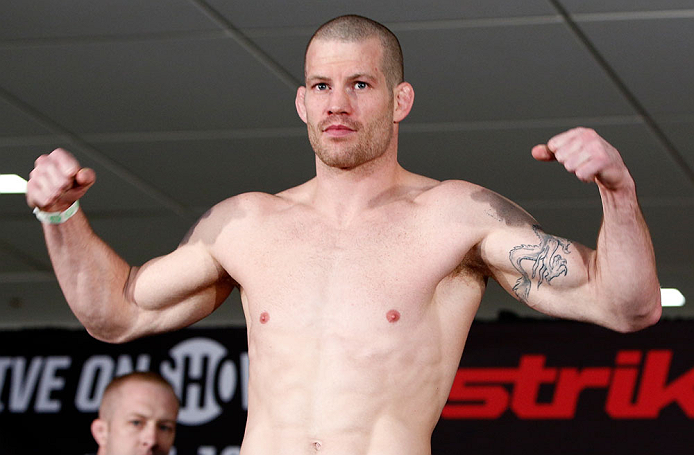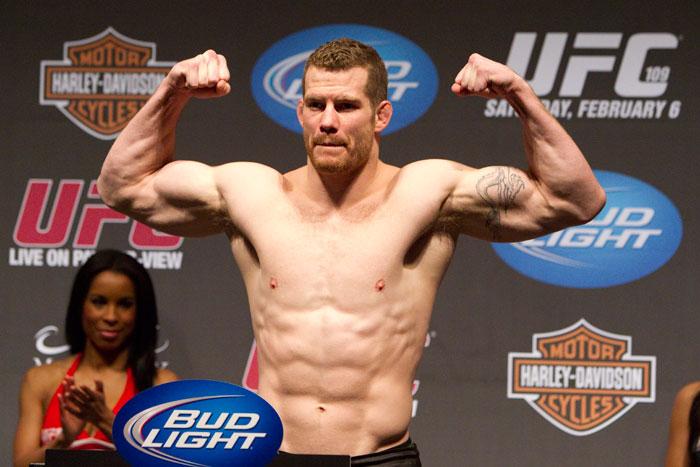 Nate “The Great” Marquardt (35-11-2) is set to make his UFC comeback fight against heavy-fisted striker Jake “The Juggernaut” Ellenberger (28-6-0) at UFC 158 on March 16. Marquardt, the former Strikeforce welterweight champion, is returning to the Octagon after two years away and he’s out to leave a lasting second first impression.
Nate “The Great” Marquardt (35-11-2) is set to make his UFC comeback fight against heavy-fisted striker Jake “The Juggernaut” Ellenberger (28-6-0) at UFC 158 on March 16. Marquardt, the former Strikeforce welterweight champion, is returning to the Octagon after two years away and he’s out to leave a lasting second first impression.
“I’m more experienced and more confident because there’s no more fear of the unknown,” Marquardt said. “There’s no ring rust.”
Marquardt took the fight on short notice after Ellenberger’s original UFC 158 opponent, Johny Hendricks, was tapped to step in for the injured Rory MacDonald against Carlos Condit. (Got that? No? Don’t worry about it.).
“I’m doing a lot of game planning closer to the fight than I normally would,” he admitted. “[But] I know what to expect and I’m working on getting my mind and body ready.”
Known as a well-rounded fighter with impressive athleticism, the 33-year-old Marquardt — who last fought in the UFC as a middleweight before finding his home at 170 pounds — has worked hard to evolve his training methods along with his technical skill.

For a closer look at Marquardt’s training, we asked his trainer Loren Landow, the director of sports performance at the Steadman Hawkins Clinic in Denver, Colorado to supply us with a sample “speed-power” workout.
“The philosophy behind doing a strength exercise followed by a speed exercise is to increase motor unit recruitment,” Landow explains. “The body recruits more muscle tissue to do a job based on need — the heavier something is the more motor units [the body] will recruit. So doing a heavy exercise followed by a light exercise, it’s almost tricking the nervous system to recruit more and more to do the job.”
After spending roughly 15 minutes on a dynamic warm-up, here’s an example of what Landow puts Marquardt through:
Move: Central nervous system sprints
Sets: 5 sets with 45 seconds rest between each set
How it’s done: Marquardt starts on his back or stomach. When Landow signals, Marquardt quickly gets up and into a fighting stance, where he’ll move his feet in an “in and out” pattern as fast as possible. Then, after Landow signals again, he’ll perform a 20-yard sprint.
 Landow says: “This works on Nate’s reactive ability, and it’s also helping his nervous system fire at a faster rate.”
Landow says: “This works on Nate’s reactive ability, and it’s also helping his nervous system fire at a faster rate.”
Move: Hurdle hops
Sets: 3 sets with 90 seconds rest between each set
How it’s done: Six 36-inch track and field hurdles are lined up in a row. Marquardt will hop through them in succession looking to minimize how long he spends on the ground while maximizing his height over each hurdle. On the final jump, he sticks his landing in athletic position.
Landow says: “These focus on explosiveness. Also, when Nate sticks the landing it’s helping with injury prevention to the ankle, knee, and hip joint.”
Exercise pair #1: Deadlift and Vertimax multiple response jumps
A Vertimax multiple response jump is, essentially, stepping onto a platform that has elastic resistance bands attached to it, and performing a vertical jump while holding the bands.
Set 1:
Deadlift 5 reps (275 lbs.)
Vertimax multiple response jumps 5 jumps
Rest: 3 min.
Set 2:
Deadlift 5 reps (315 lbs.)
Vertimax multiple response jumps 5 jumps
Rest: 3 min.
Set 3:
Deadlift 3 reps (335 lbs.)
Vertimax multiple response jumps 5 jumps
Rest: 3 min.
Landow says: “You can also sub the deadlift for a trap bar or barbell squat.”
Exercise pair #2: Close-grip pull-up and SandBell slam
SandBells (rubber sandbags) are a good alternative to medicine balls for some exercises because A) they won’t roll away; B) they won’t bounce up into your face; and C) you can achieve full power on every rep (a medicine ball’s rebound can often translate into performing a half rep).
Set 1:
Close-grip pull-up 5 reps (50 lbs. around waist)
SandBell slam 6 reps (15-pound SandBell)
Rest: 3 min.
Set 2:
Close-grip pull-up 5 reps (75 lbs. around waist)
SandBell slam: 6 reps (15-pound SandBell)
Rest: 3 min.
Set 3:
Close-grip pull-up 5 reps (100 to 110 lbs. around waist)
SandBell slam 6 reps (15-pound SandBell)
Rest 3 min.
 Exercise pair #3: Flat dumbbell press and medicine ball drop
Exercise pair #3: Flat dumbbell press and medicine ball drop
When doing medicine ball drops, a training partner will stand on a bench (or any elevated platform) that’s perpendicular to Marquardt, who is on his back with his head toward the bench. The partner will drop the medicine ball to Marquardt’s chest; he’ll catch it with both hands, quickly touch his chest with the ball, and then throw it back to his partner as explosively as possible.
Set 1
Flat DB press 5 reps (85 lbs.)
Med-ball drop 6 reps (10-pound ball)
Rest 3 min.
Set 2
Flat DB press 5 reps (100 lbs.)
Med-ball drop 6 reps (10-pound ball)
Rest: 3 min.
Set 3
Flat DB press 3 reps (110 lbs.)
Med-ball drop 6 reps (10-pound ball)
Rest 3 min.
Exercise pair #4: Physio ball rotations and SandBell power rotations
For SandBell power rotations: Get into an athletic stance near a wall, grab a SandBell, and do a trunk rotation, generating as much force as possible before releasing the SandBell into the wall at the end of the movement. For an explanation on physio ball rotations, go here.
Set 1
Physio ball rotations 5 reps (each side)
SandBell power rotations 5 reps (10-pound SandBell)
Rest: 3 min.
Set 2
Physio ball rotations 5 reps (each side)
SandBell power rotations 5 reps (10-pound SandBell)
Rest 3 min.
Set 3
Physio ball rotations 5 reps (each side)
SandBell power rotations 5 reps (10-pound SandBell)
Rest 3 min.
Landows says: “We’re working on rotary strength and power here. That will help Nate in areas including kicking, punching, takedown defense, and submission attempts.”
Cooldown
Marquardt completes the workout with a foam roller, putting much of the emphasis on his legs; he also engages in active isolated stretching (AIS).